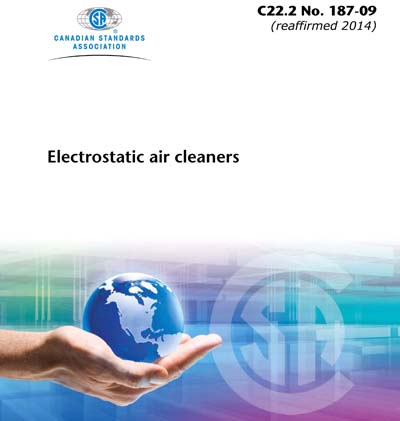Historical
CSA C22.2 No. 187-2009 (R2014)
C22.2 NO. 187-09 - Electrostatic air cleaners
Update #1 to this standard is available. To download any updates and/or register for email notification of future updates click here
Preface
This is the third edition of CSA C22.2 No. 187, Electrostatic air cleaners, one of a series of Standards issued by the Canadian Standards Association under Part II of the Canadian Electrical Code. It supersedes the previous editions, published in 1986 and 1982.Scope
1.1 This Standard applies to (a) electrostatic air cleaners intended to remove dust and dirt from the air and intended for general indoor residential and commercial use; (b) air ionizer type air cleaners; and (c) other similar ionizing equipment.1.2 This Standard does not apply to electrostatic air cleaners for use in hazardous locations or in atmospheres defined as hazardous by the Canadian Electrical Code, Part I.
1.3 This Standard does not apply to air cleaners designed to remove particles other than dust and dirt normally found in heating and ventilating systems.
1.4 The requirements of this Standard apply to cord-connected and permanently connected equipment operating at nominal supply voltages up to 600 V, single-phase or polyphase, in accordance with the Rules of the Canadian Electrical Code, Part I.
1.5 This Standard does not specify requirements for the effectiveness of air cleaners with respect to the removal of airborne particles.
1.6 This Standard does not apply to electrostatic air cleaners intended for industrial use.
1.7 Air cleaners for household use that are designed to generate ozone intentionally are outside the scope of this Standard.
1.8 Ozone generators designed exclusively to be connected to air duct systems are outside the scope of this standard because the test procedures do not address this type of application.
1.9 In CSA Standards, shall is used to express a requirement, i.e., a provision that the user is obliged to satisfy in order to comply with the standard; should is used to express a recommendation or that which is advised but not required; may is used to express an option or that which is permissible within the limits of the standard; and can is used to express possibility or capability. Notes accompanying clauses do not include requirements or alternative requirements; the purpose of a note accompanying a clause is to separate from the text explanatory or informative material. Notes to tables and figures are considered part of the table or figure and may be written as requirements. Annexes are designated normative (mandatory) or informative (non-mandatory) to define their application.
CSA America, Inc. [csa]

